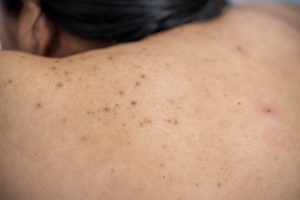An overproduction of the fungus candida causes yeast infection skin rash. Candida is a type of yeast found on the skin and body parts such as vagina, guts, throat, and mouth.
There are 20 different types of Candida yeast, and it is vital to maintain a healthy balance in the body. When there is an overproduction of this fungus, candidiasis occurs.
The most common type of yeast overgrowth infection comes from Candida albicans, which causes candidiasis. While that is the most popular, it certainly isn’t the only one. This infection can occur in or on multiple body areas; when it appears on the skin, it is called chronic mucocutaneous candidiasis.
Causes of Yeast Infection Skin Rash
Some factors can cause candida to overgrow and create an infection. These include:
Diabetes
One thing yeast loves is sugar, and thanks to diabetes, your body might have an excess supply. The sugar secreted by your sweat or urine can cause yeast on the skin to multiply and easily cause an infection.
Diabetes also lowers your immune system response, making it even easier for candida to take over. However, it is essential to note that controlling your diabetes and sugar spikes can significantly reduce the risk of getting skin candidiasis.
Hormonal Imbalances
Specifically, the hormone estrogen can cause an imbalance of candida and, eventually, an infection. Estrogen is naturally higher in women and can lead to vaginal candidiasis. Though other factors can raise your estrogen, such as:
- Pregnancy
- High-estrogen birth control
- Any estrogen hormone replacement therapy
Antibiotics Use
Antibiotics kill off harmful bacteria and, unfortunately, good bacteria. The body has plenty of good bacteria that keep yeast levels in check. Antibiotic use can upset this balance and cause candidiasis to occur.
Weakened Immune System
People might have a weakened immune system for many reasons, from medical conditions to particular prescribed drug use. Whenever a person’s immune system is weak, it opens the door for skin infections to occur more quickly. The body has difficulty supporting the current balance of good bacteria and yeast while fighting harmful bacteria.
Excess Weight
Excessive weight can increase the risk of diabetes, increasing the risk of candidiasis, as stated earlier. In addition to that, extra skin folds create a perfect home for candidiasis to grow.
How Do You Get a Candida Rash?
Yeast likes warm and moist places, making the genital regions, underarms, and skin folds perfect. While the body can usually fight off any risk of infection, certain factors don’t always allow the body to win. In addition, any cut or skin breakage in those areas can cause yeast to enter and infect the body. When it appears on the skin, it is called cutaneous candidiasis.
People can still get a yeast overgrowth infection even with zero risk factors. Those at most risk include children with dark and often wet diapers, giving ample reason for yeast to grow. People with skin folds also have a significant chance of getting candidiasis, especially in body areas like under the breast.
Babies and adults can also develop an oral candidiasis known as thrush. This can be due to a lack of oral hygiene, sugary foods (or milk babies drink), and the use of dentures.
What Does a Yeast Infection Skin Rash Look Like?
A yeast overgrowth infection can look different depending on where it is. Below are some of the most common types and what they may appear as.
Thrush
This yeast overgrowth of the mouth appears as white patches in the mouth and throat. This is commonly mistaken in babies as leftover milk but can not be wiped away like milk. Attempting to wipe these white spots can cause the skin to bleed and inflame.
Vaginal Candidiasis
Candidiasis in or around the vagina can cause a white discharge that many compare to cottage cheese. The surrounding area might also be itchy, or you may experience pain with sex or urination.
Men can also be infected with this type of candidiasis. They might see redness or redness with white spots on their penis and surrounding area. It can also cause a jock itch, soreness, or skin peeling.
It is important to note that blisters are not associated with yeast overgrowth of either gender. You should always consult a doctor for definite answers on any pain, rash, or blisters on your genitals.
Diaper Rash
With infants, there are multiple types of diaper rashes. If a yeast infection causes their rash, the skin will appear red but not raised. It is also noted as having sharp, scalloped edges. These rashes might be warm to the touch, itchy, or painful.
Thrush can be painful and cause you to want not to eat or drink too much. Some symptoms include dehydration, dry mouth, extra tiredness, decreased or bright yellow urine, headache, dizziness, and no tears while crying.

Read also: This Is Why You Can Get A Yeast Infection From Antibiotics
What Exams or Tests Do Doctors Use to Diagnose Candidiasis?
Most doctors can assess and diagnose a yeast infection with a simple look at the affected area. Other tests might be ordered, especially if a condition lasts longer than expected or is recurring often.
For vaginal candidiasis, you may receive a complete gynecological exam. This includes inserting a speculum to hold the vagina open while a doctor uses a swab to collect a sample of the infection. They might also use their fingers to feel the uterus and ovaries to detect any soreness or swelling.
Doctors might collect a small sample to test for other types of candidiasis, such as thrush or skin infections. This usually includes placing the selection on a slide with potassium hydroxide to check for a branching pattern. This pattern indicates a yeast overgrowth.
Home Remedies for Skin Yeast Infection
While many over-the-counter or prescription medications are available for candidiasis and candida rash, some prefer a more natural approach. If you have a preexisting health condition or a recurring infection, check with your doctor before attempting home remedies.
For skin-based candidiasis, specific research indicates essential oils can stop candida growth. Mint and lavender specifically have been shown to clear up infections, sometimes faster than over-the-counter medicines.
However, do not use essential oils for vaginal or oral candidiasis, as they should not be consumed or used on more sensitive areas.
Coconut oil is another tool in the home remedies arsenal that can prevent or treat candidiasis. Coconut oil has antifungal properties that help stop yeast spread and cure skin problems. Another kitchen staple known to stop candidiasis is apple cider vinegar.
In addition, tree oil applied directly to the skin for topical infections or soaked up with a tampon and inserted into the vagina for vaginal infections is effective against yeast overgrowth.
Yeast Infection Treatment Options
Doctors can use various medications to treat yeast overgrowth if you wish to go the medical route. These include topical treatments such as creams or lotions, oral pills, and suppositories.
Your doctor will prescribe the proper medication based on where the infection is located and any allergies you might have.
These include:
Nystatin– This is a liquid medication that coats the inside of the mouth and is commonly used for thrush in infants and young children. There is also a lozenge form of this medication that older kids and adults may use.
Clotrimazole – This is another type of lozenge medication to treat thrush for older children and adults.
Fluconazole and Itraconazole– Both of these are heavy-duty medications used to treat topical yeast infections. They typically come in tablet or liquid form and are used when large areas of skin are affected. They might also be used if you have an increased risk of fungal infection. Fluconazole specifically also treats vaginal yeast infections.
Terbinafine – This is another oral medication used to treat nail and skin fungal infections. This medication is commonly used to cure an athlete’s foot.
Naftifine – This gel is used to treat topical infections that don’t respond to other types of treatment.
Butoconazole, Clotrimazole, MIconazole, Terconazole, and Tioconazole – All these medications are used specifically to treat vaginal candidiasis. They come in the form of creams, ointments, and suppositories.
Is It Possible to Prevent Yeast Overgrowth?
If you want to prevent yeast infection skin rash before they start, there are a few methods to consider.
- Keep the skin dry, especially underarms, genital regions, and folds.
- Shower thoroughly after any sweat-inducing activity
- Make sure to change diapers often and keep the genital area clean and dry before applying a new one.
- Cotton underwear wicks away moisture better than other fabric types.
- A proper diet that prevents blood sugar spikes and aids in good bacteria can also help.
What Types of Doctors Treat Candida Rashes?
Many candida infections can be diagnosed and treated by your primary care doctor or pediatrician for children.
Gynecologists can diagnose and treat vaginal candidiasis, and dentists can catch thrush.
If you have severe or recurring skin candidiasis, you should see a dermatologist to determine what is causing it. If symptoms are severe, you may visit the hospital for emergency relief before seeing your primary care or dermatologist.
Read also: All You Need to Know About Yeast Infection Treatment Creams
Frequently Asked Questions
Besides topical medications, you can also use coconut oil, apple cider vinegar, or tea tree oil on skin infections. In addition, it is always good practice to keep the skin clean and dry, using just water to clean.
Yeast infections can include just the rash symptom or be itchy, warm to the touch, and sometimes mildly painful. Vaginal yeast infections can also cause discomfort during sex or urination.
Most fungal rashes will steadily get better over a week. You will want to see a medical professional if your infection doesn’t clear or worsen in that timeframe.
Drinking plenty of water and using topical ointments or creams can control itchiness. It is important not to scratch to prevent the rash from persisting longer or spreading.
Certain diaper creams are highly effective in preventing or treating fungal-related diaper rashes. These include creams like zinc oxide and petroleum jelly, which dry out the diaper area. Other over-the-counter creams that can be used include Desitin, A + D ointment, Triple Patse, and Vaseline.





